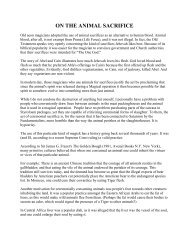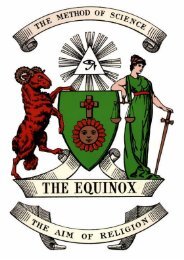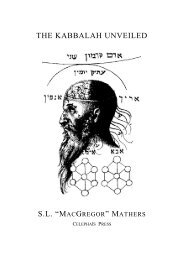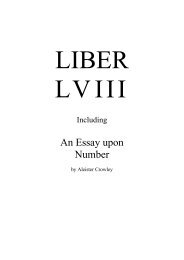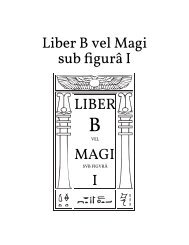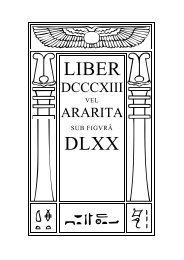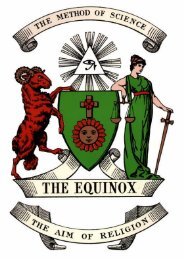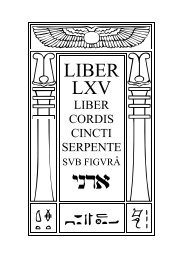Annotated Ritual of the Eucharist
Annotated Ritual of the Eucharist
Annotated Ritual of the Eucharist
Create successful ePaper yourself
Turn your PDF publications into a flip-book with our unique Google optimized e-Paper software.
Silence.<br />
The PRIESTESS takes, uncovers, and <strong>of</strong>fers <strong>the</strong> Cup, as before.<br />
The PRIEST: In my mouth be <strong>the</strong> essence <strong>of</strong> <strong>the</strong> joy <strong>of</strong> <strong>the</strong> earth!<br />
He takes <strong>the</strong> Cup, makes on <strong>the</strong> PRIESTESS, 129 drains it and<br />
returns it. 130<br />
Silence.<br />
He rises, takes <strong>the</strong> Lance, and turns to <strong>the</strong> PEOPLE.<br />
The PRIEST: There is no part <strong>of</strong> me that is not <strong>of</strong> <strong>the</strong> Gods. 131<br />
Those <strong>of</strong> <strong>the</strong> PEOPLE who intend to communicate, and none o<strong>the</strong>r<br />
should be present, having signified <strong>the</strong>ir intention, a whole Cake <strong>of</strong><br />
Light, and a whole goblet <strong>of</strong> wine, have been prepared for each<br />
one. 132<br />
The DEACON marshals <strong>the</strong>m; <strong>the</strong>y advance one by one to <strong>the</strong> altar. 133<br />
The children take <strong>the</strong> Elements and <strong>of</strong>fer <strong>the</strong>m. 134<br />
The PEOPLE communicate as did <strong>the</strong> PRIEST, 135 uttering <strong>the</strong> same<br />
words in an attitude <strong>of</strong> Resurrection: “There is no part <strong>of</strong> me<br />
that is not <strong>of</strong> <strong>the</strong> Gods.” 136<br />
128 The Priest should take care to consume <strong>the</strong> entire Host, including both portions, and any crumbs that may<br />
have become dislodged.<br />
129 I make a green cross with <strong>the</strong> circular cup on <strong>the</strong> Priestess. This gesture unites <strong>the</strong> cross and circle as time<br />
and space.<br />
130 “Drains it” means to drink <strong>the</strong> entire contents (not required <strong>of</strong> <strong>the</strong> people in <strong>the</strong>ir communion). He must be<br />
sure to consume <strong>the</strong> particle <strong>of</strong> Host that was put into <strong>the</strong> wine. Certain cup designs may make this difficult. By<br />
leaving a spoonful or so <strong>of</strong> wine at <strong>the</strong> bottom and giving it a good swirl before finishing, <strong>the</strong> Priest should be<br />
able to get <strong>the</strong> particle free. In <strong>the</strong> event that it sticks anyhow, <strong>the</strong>re’s no shame in going in after it with a finger!<br />
131 These words should be spoken in <strong>the</strong> “attitude <strong>of</strong> Resurrection”: arms crossed over <strong>the</strong> breast with<br />
fingertips at shoulders.<br />
132 A “common cup” is expressly contradicted by this rubric. Ordinary goblet-style wine glasses are best for<br />
popular communion. If possible, <strong>the</strong>y should be filled in advance, but <strong>the</strong>y may (if necessary) be filled as<br />
communicants approach.<br />
133 The Deacon may queue up <strong>the</strong> people, but each person in turn communicates individually in <strong>the</strong> East, not in<br />
simultaneous groups. If <strong>the</strong>re are musicians, it is a good idea to have <strong>the</strong>m communicate first, so that <strong>the</strong>y can<br />
play continuously for <strong>the</strong> remainder <strong>of</strong> popular communion.<br />
134 The children take <strong>the</strong> elements from <strong>the</strong> Priestess at <strong>the</strong> High Altar (see note 84). Only <strong>the</strong> Priest<br />
communicates at <strong>the</strong> hands <strong>of</strong> <strong>the</strong> Priestess. In Masses where <strong>the</strong> <strong>of</strong>fices <strong>of</strong> <strong>the</strong> children are vacant, <strong>the</strong> Deacon<br />
must <strong>of</strong>fer <strong>the</strong> elements to <strong>the</strong> people. There has been much discussion about whe<strong>the</strong>r it is “appropriate” for<br />
<strong>the</strong> people to mount <strong>the</strong> steps <strong>of</strong> <strong>the</strong> dais in order to communicate. The “symbolism” which justifies this<br />
prohibition in some quarters has never persuaded me. I see no problem with communicants coming up <strong>the</strong><br />
steps, if <strong>the</strong> dais is sufficiently ample that <strong>the</strong>y are not crowding <strong>the</strong> Priestess. In any case, <strong>the</strong> children <strong>of</strong>fering<br />
<strong>the</strong> elements can very effectively indicate where people are to stand for communion by positioning <strong>the</strong>mselves<br />
<strong>the</strong>re.<br />
135 I.e. eat a cake, <strong>the</strong>n drink <strong>the</strong> wine. They may make crosses with <strong>the</strong> elements, but excessive elaboration<br />
should be avoided, even if it somehow reflects <strong>the</strong> earlier words or actions <strong>of</strong> <strong>the</strong> Priest. The Priest’s own<br />
Liber XV with Practical Annotations by T Polyphilus, Ep. Gn. 25



